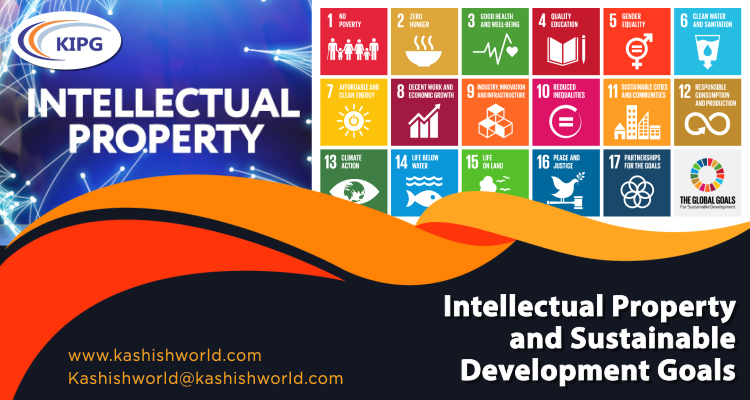
Interlinking IP and Sustainable Development
Intellectual Property (IP), through its passive presence, has touched all domains of knowledge like education, entertainment-media, art, technology, literature, music, etc. The role assumed by the Intellectual Property Laws has widened over the years due to their interaction with other laws and international agreements. It has taken the character of an ‘enabling’ principle. The same stands true when one says that IP influences sustainable development goals. On the one hand, IP enables development by incentivizing innovation, and, on the other hand, it also hampers it by locking inventions, specifically in agriculture and pharmaceuticals, by granting exclusive rights to the proprietors.
The Sustainable Development Goals (SDGs) adopted by the UN General Assembly in 2015 lay down border goals than the Millennium Development Goals (2000-2015). The SDGs indicate the interlinkage between IP and Development by providing for a goal to “build resilient infrastructure, promote sustainable industrialization, and foster innovation.” WIPO’s (World Intellectual Property Organization) Director General Francis Gurry, emphasizing the relationship between the two, said that IP “exists to create an enabling environment for and to stimulate investment in innovation.” Also, the UNHRC and the WIPO in their joint-publication, namely, ‘IP and Human Rights,’ concluded that “appropriate IP protection can contribute to the economic, social and cultural progress of the world’s diverse population.”
These goals can be realized well if collaborative efforts are taken so to ensure:
- Capacity-building
- Technological learning
- Technology transfer across borders
A Sustainable Development Goal (SDG) that could be read in line with the Intellectual Property Rights (IPRs) is the SDG Target 3b, which states that the flexibilities within the Agreement on Trade-Related Aspects of Intellectual Property Rights (TRIPS) shall be used to protect public health by enabling access to affordable medicines and vaccines, for both, communicable and non-communicable diseases. The Doha Declaration helps in this aspect by providing for a detailed provision to promote Compulsory Licensing of medicines to secure public health in times of national emergency or extreme urgency.
Other SDGs, which are relevant to IP, are mentioned below:
- SDG 2 – End hunger, achieve food security and improved nutrition, and promote sustainable agriculture.
- SDG 3 – Ensure healthy lives and promote well-being for all at all ages.
- SDG 4 – Ensure inclusive and equitable quality education and promote lifelong learning opportunities for all.
- SDG 7 -Ensure access to affordable, reliable, sustainable, and modern energy for all.
- SDG 8 – Promote sustained, inclusive, and sustainable economic growth, full and productive employment, and decent work for all.
- SDG 13 – Take urgent action to combat climate change and its impacts.
How Technology-Transfer can Help Meet Developmental Goals?
For developing a particular technology, a lot of effort, resources, and money are invested with the accompanying risk of failure. The same stands true for both the first-world and third-world nations, and it is here where collaboration could help bridge the gap and ensure reciprocity later. Technology transfer refers to the assignment of rights to  manufacture, use, etc., specific technology and the ancillary knowledge surrounding it, which is needed to avail the benefit of such technology for the mutual advantage of both the parties of a given transaction. Participation in such transfer can be availed through an inter-governmental collaboration or even by non-state actors like IGOs (Inter-Governmental Organizations) or NGOs (Non-Governmental Organizations) or NPOs (Non-Profit Organizations) to encourage the growth of new inventions and outspread of knowledge.
manufacture, use, etc., specific technology and the ancillary knowledge surrounding it, which is needed to avail the benefit of such technology for the mutual advantage of both the parties of a given transaction. Participation in such transfer can be availed through an inter-governmental collaboration or even by non-state actors like IGOs (Inter-Governmental Organizations) or NGOs (Non-Governmental Organizations) or NPOs (Non-Profit Organizations) to encourage the growth of new inventions and outspread of knowledge.
It is also amply clear that the level of benefits accruing from IP is proportional to a country’s level of development achieved and the availability of skill-crafted labor. The Least Developed Countries (LDCs) and developing countries generally have a low absorptive capacity due to a lack of infrastructure and specialized labor force. The SDG came to the rescue of such nations since the UN launched the Technology Facilitation Mechanism (TFM), which was established by the Addis Ababa Action Agenda (AAAA) to support the SDGs. It helps in the transfer of technology to improve the capacity of such LDCs to enable benefits from Science and Technology Innovations (STI). Therefore, it can be seen that both SDG and IP of developed, developing, and LDC countries play an inter-dependent role in accelerating one another. The TRIPS Agreement in article 66 also states that the members of developed countries shall provide incentives to enterprises and institutions in their territories for promoting and encouraging technology transfer to least-developed country members to enable them to create a sound and viable technological base.
This collaborative framework finds mention in SDG 17, which states that it shall be an endeavor to “strengthen the means of implementation and revitalize the global partnership for sustainable development.” Now, such collaboration is an integral step in ‘cross-cutting,’ which is the linking of interests of separate independent parties. Also, it helps in building socio-economic relationships, soft/tacit knowledge, and knowledge of the hardware itself, which also impacts product distribution. For instance, WIPO’s ‘Re: Search’ initiative helps multiple stakeholders like BIO Ventures for Global Health to participate in the furtherance of public health. Similarly, WIPO’s Accessible Books Consortium (ABC) initiative provides for better access to published recourses to Visually Impaired People (VIP). For the dissemination of soft knowledge, publications play a huge role. The HathiTrust, in collaboration with Google Books and other university libraries, helps meet the information needs as also stated as an objective under the SDG. The examples stated above show that collaboration may be between private parties or between governments or between both private parties and governmental organizations.
Can Openness in the IP System Help Achieve the SDGs?

As already observed, a partnership can help aid development. When such partnerships are built based on openness, tremendous good can be derived from it in favor of public health and benefit. As often observed, medicines for treating serious and life-threatening diseases, like HIV/AIDS, are unevenly distributed due to differential access to health-care. Hence, partnerships can help improve the administration of such medical aid. For instance, ‘The Medicine Patent Pool’ (MPP) is an initiative based on a partnership to improve access to such medicines at affordable rates to developing nations. It helps provide access to medicines for treating conditions of patients of HIV, Hepatitis C, and TB, including the research on such medication. ‘Open AIR’ also embraces a partnership-oriented approach to conduct research activities through collaborative efforts across the African continent.
Green Technology and Sustainable Development
The SDG 13 states the urgency in action to “combat climate change and its impact.” The specific goal aims to garner US$ 100 Billion annually by 2020 to address the requirements of third-world nations to adapt to climate change. The same requires the development and dissemination of green and environment-friendly technology. In furtherance of the same, the International Patent Classification Committee developed an ‘IPC Green Inventory,’ which stores and enables its users to access patient-related information surrounding green technologies dealing in alternative energy production, energy conservation, nuclear power generation, transportation, management of waste, agriculture forestry as well as other design-related aspects. It also helps achieve the agenda laid under Article 7 of the Trade-Related Aspects of Intellectual Property Rights (TRIPS), which states that IPR shall “promote technological innovation and the transfer and dissemination of technology, to the mutual advantage of producers and users of technological knowledge and in a manner conducive to social and economic welfare, and to a balance of rights and obligations.”
In furtherance of such objectives, the US and China have joined hands to promote R&D activates in clean energy technologies in the form of a ‘Clean Energy Research Centre.’ Similarly, India and the US have partnered for addressing and meeting sustainability challenges by the establishment of the Joint Clean Energy Research and Development Centre (JCERDC). WIPO has also played a crucial role in the form of its initiative, WIPO GREEN, which stimulates environment-friendly technologies and puts together inventors, innovators, and users to improve access, help commercialize through buy-outs and licensing of such technology. An example of this is CloudFisher that helped in introducing access to clean water in places where there is a shortage of clean drinking water.
Conclusive Remarks
The above-stated list of SDGs helps establish the role of IP in development on holistic grounds and identifies the need for IP in meeting the SDGs. The diffusion of technology is the key factor in promoting the goals mentioned above. IP can, therefore, not be treated in seclusion since it is interdependent on many socio-political and economic factors, which in turn, also determine not only the fate of SDGs but also itself. Forming partnerships and initiating collaborative ventures are of core value to the 2030 Agenda for the realization of these goals. While contributing resources, all countries alike should pool-in their efforts without resting an arm on developing countries only. Also, the industrial and economic frameworks at the national, regional, and international levels play a critical role as they help define and regulate policies concerning the various sectors.

